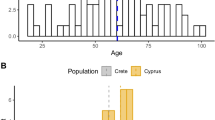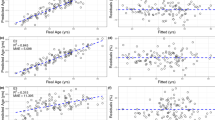Abstract
The transposition of traditional biological profiling methods to virtual skeletal reconstructions represents a relatively novel practice that is proving to be versatile in a variety of forensic contexts. Widespread acknowledgement of the disadvantages associated with archaeological and/or other non-contemporary skeletal collections has prompted an increase in the use of medical imaging modalities for the purposes of formulating population-specific reference standards used to estimate characteristics such as chronological age. The primary aim of the present study is to statistically evaluate the reproducibility of assessment and thereafter develop age estimation standards based on the morphoscopic evaluation of the fourth right sternal rib following the phase ageing method developed as reported by İşcan et al. (J Forensic Sci 29:1094–1104, 1984, J Forensic Sci 30:853–863, 1985) in clinical multi-slice computed tomography (MSCT) scans. A total of 335 MSCT scans representing Western Australian individuals between 10 and 80 years of age (179 male and 156 female) were retrospectively reconstructed and analysed in OsiriX following the İşcan et al. sex-specific standards (J Forensic Sci 29:1094–1104, 1984, J Forensic Sci 30:853–863, 1985) for the fourth right rib. Regression and transition analyses are employed to generate standards for the estimation of chronological age and modelling of thoracic senescence, respectively. The method was also applied to right ribs three and five to evaluate intercostal variance in age-related metamorphosis. Intra- and inter-observer accordance is ‘substantial’ (K = 0.76) and ‘almost perfect’ (K = 0.825), respectively. Intercostal variances between ribs three to five were observed in the male sample only. Multiple regression using phase scores from all three ribs produced models with the highest predictive accuracy (± 10.04 years for males and ± 9.81 years for females). The transition analyses demonstrate comparable levels of age-related morphological change across ribs and male and female samples. This study presents a novel set of reference standards for a contemporary Australian population and further demonstrates the utility of virtual analysis in forensic anthropology.



Similar content being viewed by others
References
Brough AL, Rutty GN, Black S, Morgan B (2012) Post mortem computed tomography and 3D imaging: anthropological applications for juvenile remains. Forensic Sci Med Pathol 8:270–279
Dedouit F, Saint-Martin P, Mokrane FZ, Savall F, Rousseau H, Crubezy E, Rouge D, Telmon N (2015) Virtual anthropology: useful radiological tools for age assessment in clinical forensic medicine and thanatology. Radiol Med 120:874–886
Franklin D, Swift L, Flavel A (2016) Virtual anthropology and radiographic imaging in the forensic medical sciences. Egypt J Forensic Sci 6(2):31–43
Grabherr S, Cooper C, Ulrich-Bochsler S, Ross S, Oesterhelweg L, Bolliger S, Christie A, Schnyder P, Mangin P, Thali MJ (2009) Estimation of sex and age of virtual skeletons—a feasibility study. Eur Radiol 19:419–429
Bocquet-Appel JP, Masset C (1982) Farewell to paleodemography. J Hum Evol 11:321–333
Boldsen JL, Milner GR, Konigsberg LW, Wood JW (2002) Transition analysis: a new method for estimating age from skeletons. In: Hoppa RD, Vaupel JW (eds) Paleodemography: age distributions from skeletal samples. Cambridge University Press, Cambridge, pp 73–106
Dirkmaat DC, Cabo LL, Ousley SD, Symes SA (2008) New perspectives in forensic anthropology. Yearb Phys Anthropol 51:33–52
Franklin D, Cardini A, Flavel A, Kuliukas A (2013) Estimation of sex from cranial measurements in a Western Australian population. Forensic Sci Int 229:158.e1–158.e8
Kimmerle EH, Konigsberg LW, Jantz RL, Baraybar JP (2008) Analysis of age at death estimation through the use of pubic symphyseal data. J Forensic Sci 53(3):558–568
Lottering N, MacGregor DM, Meredith M, Alston CL (2013) Evaluation of the Suchey-Brooks method of age estimation in an Australian subpopulation using computed tomography of the pubic symphyseal surface. Am J Phys Anthropol 150:386–399
Ubelaker DH, DeGaglia CM (2017) Population variation in skeletal sexual dimorphism. Forensic Sci Int 278:407-e.1
Franklin D, Cardini A, Flavel A, Kuliukas A, Marks MK, Hart R, Oxnard C, O’Higgins P (2013) Concordance of traditional osteometric and volume rendered MSCT landmark cranial measurements. Int. J Legal Med 127:505–520
Verhoff MA, Ramsthaler F, Krahahn J, Deml U, Gille RJ, Grabherr S, Thali MJ, Kreutz K (2008) Digital forensic osteology—possibilities in cooperation with the virtopsy project. Forensic Sci Int 174:152–156
Barrier P, Dedouit F, Braga J, Joffre F, Rouge D, Rousseau H, Telmon N (2009) Age at death estimation using multi-slice computed tomography reconstructions of the posterior pelvis. J Forensic Sci 54(4):773–778
Telmon N, Gaston A, Chemla P, Blanc A, Joffre F, Rouge D (2005) Application of the Suchey-Brooks method to three-dimensional imaging of the pubic symphysis. J Forensic Sci 50(3):1–6
Wink AE (2014) Pubic symphyseal age estimations from three-dimensional reconstructions of pelvic CT scans of live individuals. J Forensic Sci 59(3):696–702
Dedouit F, Bindel S, Gainza D, Blanc A, Joffre F, Rouge D, Telmon N (2008) Application of the İşcan method to two- and three- dimensional imaging of the sternal end of the right fourth rib. J Forensic Sci 53(2):288–295
İşcan MY, Loth SR, Wright RK (1984) Age estimation from the rib by phase analysis: white males. J Forensic Sci 29(4):1094–1104
İşcan MY, Loth SR, Wright RK (1985) Age estimation from the rib by phase analysis: white females. J Forensic Sci 30(3):853–863
Loth SR, İşcan MY, Scheuerman EH (1994) Intercostal variation at the sternal end of the rib. Forensic Sci Int 65:135–143
Martrille L, Ubelaker DH, Cattaneo C, Seguret F, Tremblay M, Baccino E (2007) Comparison of four skeletal methods for the estimation of age at death on white and black adults. J Forensic Sci 52(2):302–307
Merritt CE (2014) A test of Hartnett’s revisions to the pubic symphysis and fourth rib methods on a modern sample. J Forensic Sci 59(3):703–711
İşcan MY, Loth SR, Wright RK (1987) Racial variation in the sternal extremity of the rib and its effect on age determination. J Forensic Sci 32(2):452–466
Oettle AC, Steyn M (2000) Age estimation from the sternal ends of ribs by phase analysis in South African blacks. J Forensic Sci 45(5):1071–1079
Salem NH, Aissaoui A, Mesrati MA, Belhadj M, Quarterhomme G, Chadly A (2014) Age estimation from the sternal end of the fourth rib: a study of the validity of İşcan’s method in Tunisian male population. Legal Med 16:385–389
Yavuz MF, Isçan MY, Cologlu AS (1998) Age assessment by rib phase analysis in Turks. Forensic Sci Int 98:47–54
Fanton L, Gustin M-P, Paultre U, Schrag B, Malicier D (2010) Critical study of observation of the sternal end of the right 4th rib. J Forensic Sci 55(2):467–472
Hartnett KM (2010) Analysis of age at death estimation using data from a new, modern autopsy sample—part II: sternal end of the fourth rib. J Forensic Sci 55(5):1152–1156
Garvin HM, Passalacqua NV (2012) Current practices by forensic anthropologists in adult skeletal age estimation. J Forensic Sci 57(2):427–433
Australian Bureau of Statistics. 2016 Census QuickStats. http://quickstats.censusdata.abs.gov.au/census_services/getproduct/census/2016/quickstat/5GPER?opendocument. Accessed 28/11/18
İşcan MY, Loth SR, Wright RK (1993) Casts of age phases from the sternal rib end of the rib for white males and females. France Casting, Fort Collins
Cohen JW (1960) A coefficient of agreement for nominal scales. Educ Psychol Meas 20(1):37–46
Konigsberg LW, Herrmann NP, Wescott DJ, Kimmerle EH (2008) Estimation and evidence in forensic anthropology: age at death. J Forensic Sci 53(3):541–556
Langley-Shirley N, Jantz R (2010) A Bayesian approach to age estimation in modern Americans from the clavicle. J Forensic Sci 55(3):571–582
Shirley N, Jantz RL (2011) Spheno-occipital synchondrosis fusion in modern Americans. J Forensic Sci 56(3):80–584
Landis JR, Koch GG (1977) The measurement of observer agreement for categorical data. Biometrics 33:159–174
Cohen JW (1988) Statistical power analysis for the behavioural sciences, 2nd edn. Lawrence Erlbaum Associates, Hillsdale
İşcan MY, Loth SR (1986) Determination of age from the sternal rib in white males: a test of the phase method. J Forensic Sci 31(1):122–132
İşcan MY, Loth SR (1986) Determination of age from the sternal rib in females: a test of the phase method. J Forensic Sci 31(3):990–999
Yoder C, Ubelaker DH, Powell JF (2001) Examination of variation in sternal rib end morphology relevant to age assessment. J Forensic Sci 46(2):223–227
Garcia-Martinez D, Torres-Tamayo N, Torres-Sanchez I, Garcia-Rio F, Bastir M (2016) Morphological and functional implications of sexual dimorphism in the human skeletal thorax. Am J Phys Anthropol 161(3):467–477
Solheim T, Sundes PK (1980) Dental age estimation of Norwegian adults—a comparison of different methods. Forensic Sci Int 16(1):7–17
Karkhanis S, Mack P, Franklin D (2013) Age estimation standards for a Western Australian population using the coronal pulp cavity index. Forensic Sci Int 231:412.e1–412.e6
Bosmans N, Ann P, Aly M, Willems G (2005) The application of Kvaal’s dental age calculation technique on panoramic dental radiographs. Forensic Sci Int 153:208–212
Misirlioglu M, Nalcaci R, Adisen MZ, Yilmaz S, Yorubulut S (2014) Age estimation using maxillary pulp/tooth area ratio, with an application of Kvaal’s methods on digital orthopantomographs in a Turkish sample. Aust J Forensic Sci 46(1):27–38
Elfawal MA, Alqattan SI, Ghallab NA (2015) Racemization of aspartic acid in root dentin as a tool for age estimation. Med Sci Law 55(1):22–29
Kim Y-S, Kim D-I, Park D-K, Lee J-H, Chung N-E, Lee W-T, Han S-HH (2007) Assessment of histomorphological features of the sternal end of the fourth rib for age estimation in Koreans. J Forensic Sci 52(6):1237–1242
Ford JM, Decker SJ (2016) Computed tomography slice thickness and its effects on three-dimensional reconstruction of anatomical structures. J Forensic Radiol Imaging 4:43–46
Franklin D, Flavel A (2015) CT evaluation of timing for ossification of the medial clavicular epiphysis in a contemporary Western Australian population. Int J Legal Med 129(3):583–594
Muhler M, Schulz R, Schmidt S, Schmeling A, Reisinger W (2006) The influence of slice thickness on assessment if clavicle ossification in forensic age diagnostics. Int J Legal Med 120:15–17
Milenkovic P, Djuric M, Milovanovic P, Djukic K, Zivkovic V, Nikolic S (2014) The role of CT analyses of the sternal end of the clavicle and the first costal cartilage in age estimation. Int J Legal Med 128:825–839
Mitteroecker P, Gunz P (2009) Advances in geometric morphometrics. Evol Biol 36(2):235–247
Acknowledgements
The authors wish to acknowledge the contribution of Dr. Rob Hart at Royal Perth Hospital, who obtained the MSCT scans that made this study possible.
Author information
Authors and Affiliations
Corresponding author
Additional information
Publisher’s note
Springer Nature remains neutral with regard to jurisdictional claims in published maps and institutional affiliations.
Rights and permissions
About this article
Cite this article
Blaszkowska, M., Flavel, A. & Franklin, D. Validation of the İşcan method in clinical MSCT scans specific to an Australian population. Int J Legal Med 133, 1903–1913 (2019). https://doi.org/10.1007/s00414-018-01992-0
Received:
Accepted:
Published:
Issue Date:
DOI: https://doi.org/10.1007/s00414-018-01992-0




